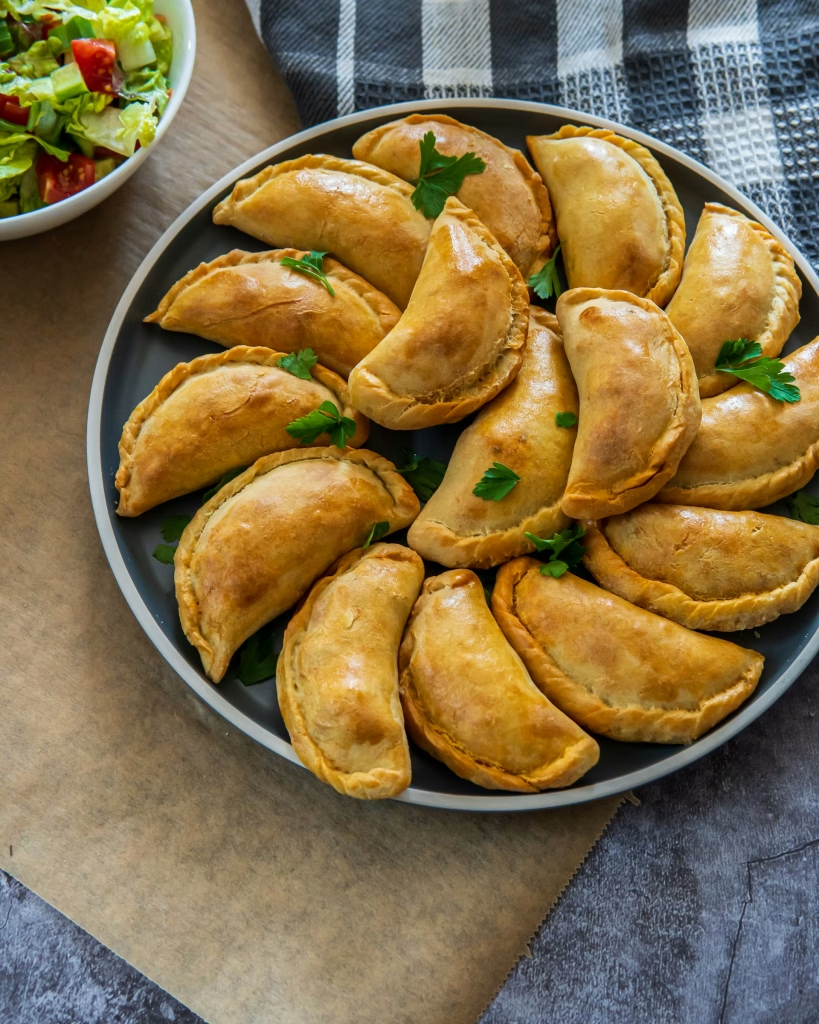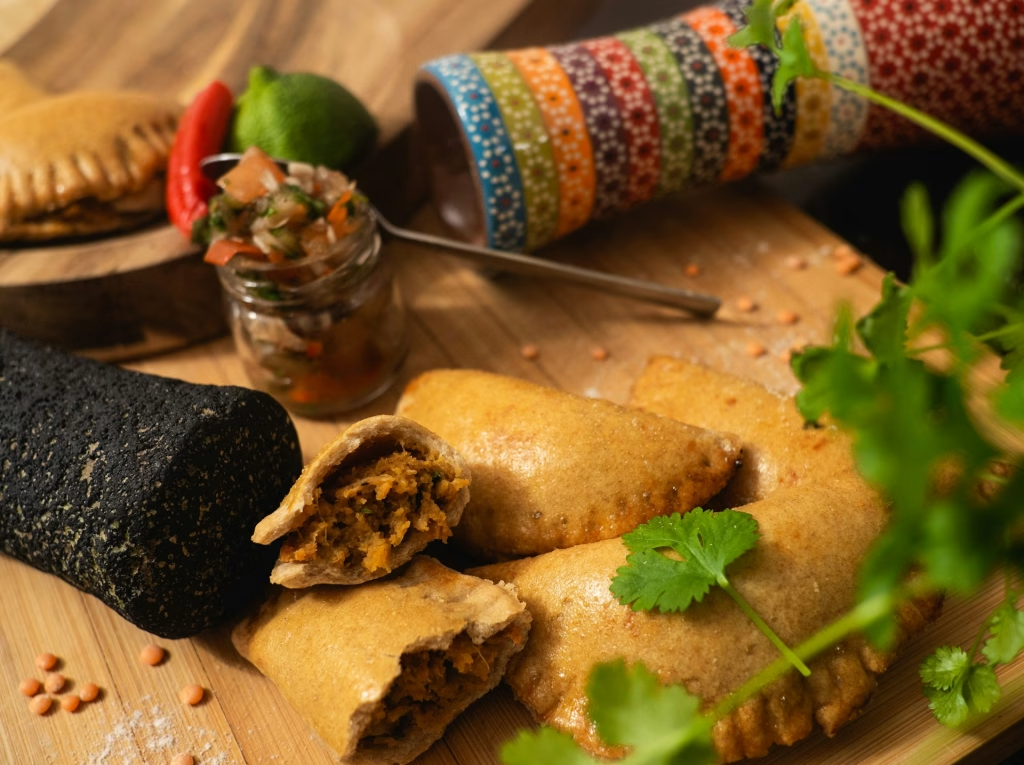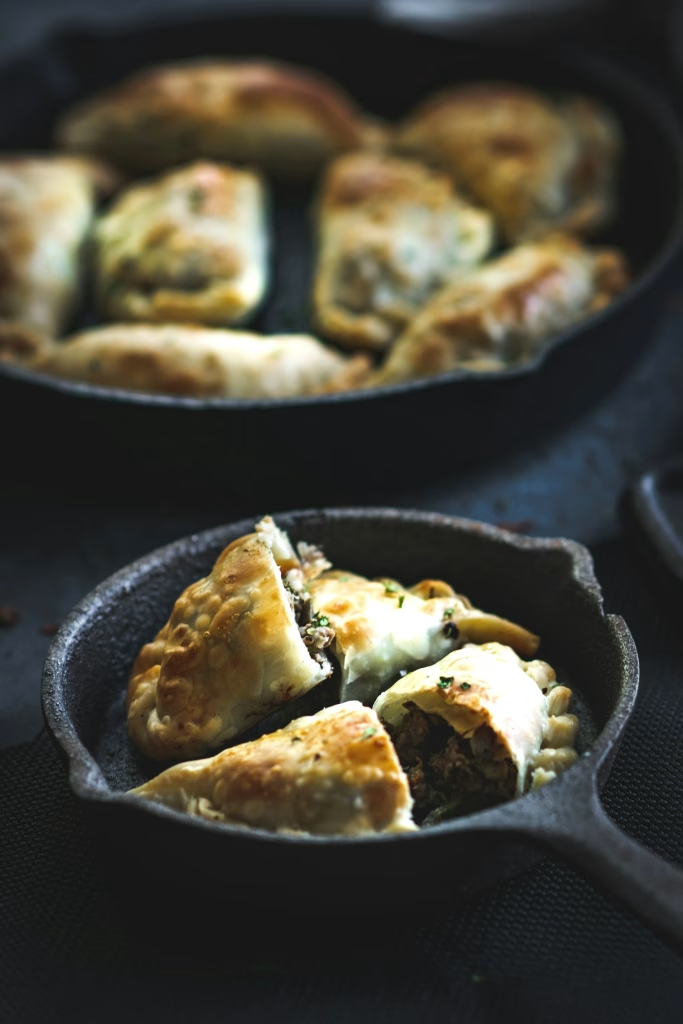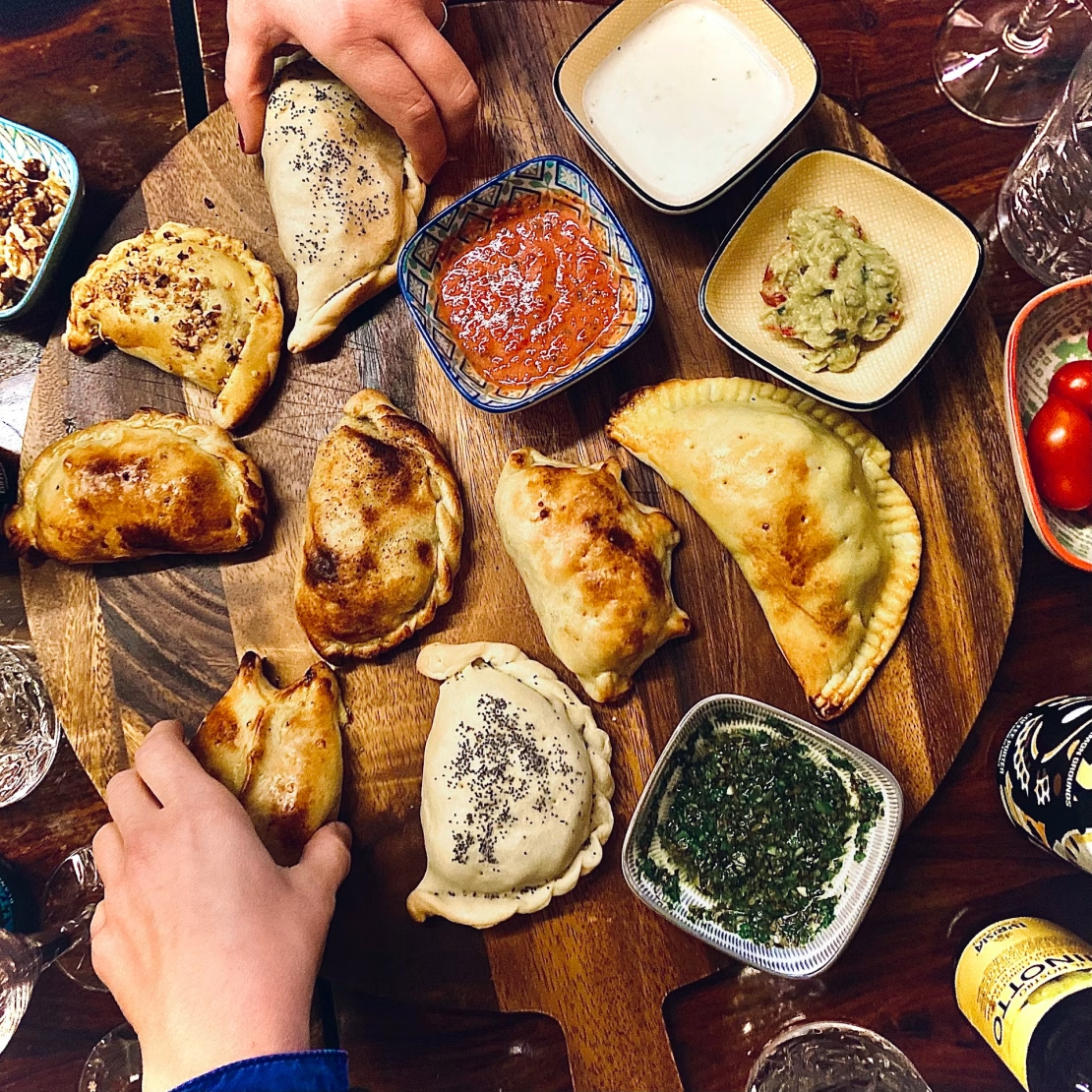Chilean Empanadas are a beloved staple in Chilean cuisine, especially known for the iconic Empanada de Pino—a savory pastry filled with a delicious mixture of seasoned beef, onions, olives, hard-boiled eggs, and raisins.
These hand-held pies are a perfect combination of flaky dough and rich fillings, traditionally baked in wood-fired ovens to achieve a golden, crispy crust.
Chilean empanadas are more than just food; they are a cultural symbol often enjoyed during national celebrations like Fiestas Patrias and family gatherings.
Table of Contents
Ingredients
For the Dough:
- 4 cups all-purpose flour
- 1 tsp salt
- 1 tsp baking powder
- 1/2 cup unsalted butter, chilled and diced
- 1 cup warm milk (about 100°F / 38°C)
- 1 large egg
For the Pino Filling (Traditional Beef Filling):
- 1 lb ground beef (preferably chuck)
- 2 large onions, finely chopped
- 3 tbsp vegetable oil
- 2 cloves garlic, minced
- 1 tsp ground cumin
- 1 tsp paprika
- 1/2 tsp chili powder (optional)
- 1/2 cup beef broth or water
- Salt and pepper to taste
- 2 hard-boiled eggs, sliced
- 12 black olives (preferably Chilean or Kalamata)
- 1/4 cup raisins
For Egg Wash:
- 1 egg, beaten with 1 tbsp water
Serves
Makes approximately 12 medium-sized empanadas (serves 6)
Step-by-Step Instructions
1. Prepare the Dough
- In a large bowl, sift together the flour, salt, and baking powder.
- Add the chilled butter and rub it into the flour with your fingertips until the mixture resembles coarse crumbs.
- In a separate small bowl, whisk the warm milk and egg together.
- Slowly pour the milk mixture into the flour mixture, stirring with a fork or your hand until the dough begins to come together.
- Transfer the dough to a floured surface and knead gently for 5 minutes until smooth and elastic.
- Wrap the dough in plastic wrap and refrigerate for at least 30 minutes.
2. Make the Pino Filling
- Heat oil in a large skillet over medium heat. Add chopped onions and cook slowly for about 15 minutes until caramelized, stirring often.
- Add garlic, cumin, paprika, and chili powder. Cook for another minute until fragrant.
- Increase heat to medium-high and add ground beef. Brown the meat, breaking it up with a spoon.
- Pour in beef broth or water, reduce heat, and simmer uncovered for 10-15 minutes until the liquid reduces and mixture thickens.
- Season with salt and pepper. Remove from heat and let cool.
3. Assemble the Empanadas
- Preheat oven to 375°F (190°C). Line a baking sheet with parchment paper.
- Roll out the dough on a floured surface to about 1/8 inch (3 mm) thick.
- Cut out 6-inch (15 cm) circles using a round cutter or bowl.
- Place about 2 tablespoons of the beef filling in the center of each dough circle.
- Top with a slice of hard-boiled egg, two olives, and a few raisins.
- Fold the dough over to form a half-moon shape. Press the edges together firmly.
- Crimp the edges by folding and pinching with your fingers or pressing with a fork to seal.
- Place the empanadas on the baking sheet.
- Brush each empanada with the egg wash for a glossy finish.
4. Bake
- Bake in the preheated oven for 20–25 minutes or until golden brown.
- Remove from oven and let cool slightly before serving.
Serving Suggestions
- Serve warm with pebre, a Chilean salsa made with tomatoes, onions, cilantro, and chili.
- Pair with a light salad or a glass of Chilean wine such as Carmenere or Sauvignon Blanc.
- Offer a side of ají verde (spicy green sauce) for an extra kick.
- For a traditional Chilean experience, serve with a cup of terremoto, a popular Chilean cocktail.

Tips for Perfect Chilean Empanadas
- Caramelize Onions Slowly: The sweetness of the onions is key to a balanced filling.
- Don’t Overfill: Too much filling can cause the empanadas to burst while baking.
- Seal Edges Well: Use the crimping technique to avoid leaks.
- Rest Dough Before Rolling: Chilling helps relax gluten and makes rolling easier.
- Use Quality Ingredients: Fresh olives, good-quality beef, and fresh eggs make a difference.

Healthier Alternatives
- Use lean ground beef or substitute with ground turkey or chicken.
- Bake instead of frying to reduce fat.
- Use whole wheat flour or a mix of whole wheat and white flour for the dough.
- Reduce oil in the caramelized onions by using a non-stick pan.
- Omit raisins or reduce quantity to lower sugar content.
Creative Variations
- Cheese Empanadas: Fill with a mix of mozzarella and queso fresco.
- Seafood Empanadas: Use shrimp or crab with a creamy sauce.
- Vegetarian Empanadas: Use mushrooms, spinach, and cheese.
- Spicy Empanadas: Add chopped jalapeños or hot sauce to the filling.
- Sweet Empanadas: Fill with fruit preserves and dust with powdered sugar for dessert.
Common Mistakes to Avoid
- Skipping the resting time for dough – dough that’s not rested can be tough and hard to roll.
- Not caramelizing onions properly – raw onions will overpower the filling.
- Overfilling empanadas – leads to bursting during baking.
- Poor edge sealing – can cause filling leakage.
- Using warm dough – warm dough is sticky and harder to handle.
- Not using enough egg wash – results in a dull crust instead of a shiny golden one.
- Baking at too high a temperature – can burn crust before filling cooks.
- Skipping the olives or eggs – these are signature elements in traditional pino.
- Not tasting the filling before assembling – seasoning adjustment is important.
- Rolling dough too thin or thick – too thin will break; too thick makes the empanadas doughy.
History of Chilean Empanadas
Empanadas have deep historical roots, introduced to Chile by Spanish colonizers during the 16th century. The word “empanada” comes from the Spanish verb empanar, meaning “to wrap or coat in bread.” The concept of enclosing meat and other fillings in dough is ancient and found in many cultures, but in Chile, the empanada evolved to become a defining culinary tradition.
Chilean empanadas became especially prominent in the central regions where cattle ranching flourished, allowing for easy access to beef. Over time, the empanada de pino—named after the spiced beef filling—became synonymous with Chilean cuisine. The recipe reflects a blend of indigenous ingredients, European influence, and the agricultural bounty of Chile.

Today, empanadas are a fixture during Chile’s national holidays, particularly Fiestas Patrias (Independence Day), where families gather to enjoy these savory pastries. They are also popular street food, reflecting Chile’s rich history and vibrant culture.
FAQs about Chilean Empanadas
1. What is the traditional filling for Chilean empanadas?
The traditional filling, called pino, includes seasoned ground beef, onions, garlic, cumin, olives, hard-boiled eggs, and raisins.
2. Can empanadas be frozen?
Yes, both raw and baked empanadas freeze well. Bake or thaw and reheat before serving.
3. Are Chilean empanadas fried or baked?
They are traditionally baked, resulting in a flaky and golden crust.
4. What kind of flour is used?
All-purpose flour is typical, but you can use a mix with whole wheat if preferred.
5. Can I use pre-made dough?
Yes, but homemade dough provides the best texture and flavor.
6. How long do empanadas keep?
Baked empanadas last 2–3 days refrigerated. Reheat before eating.
7. Are empanadas spicy?
Not traditionally; however, you can add chili or hot sauce for heat.
8. Can I make vegetarian empanadas?
Absolutely! Popular fillings include cheese, spinach, mushrooms, or mixed vegetables.
9. What is the best way to seal empanadas?
Fold the edges and crimp by pinching or pressing with a fork to ensure a tight seal.
10. Can empanadas be made gluten-free?
Yes, by using gluten-free flour blends for the dough.
Chilean Empanadas capture the heart and soul of Chilean cuisine, offering a delightful balance of flavors wrapped in a golden, flaky crust. Their rich history and cultural significance make them much more than just a savory pastry—they are a symbol of Chilean identity and hospitality. Whether enjoyed during festive celebrations or as a comforting everyday meal, these empanadas bring a piece of Chile to your table, delivering tradition and taste in every bite.


